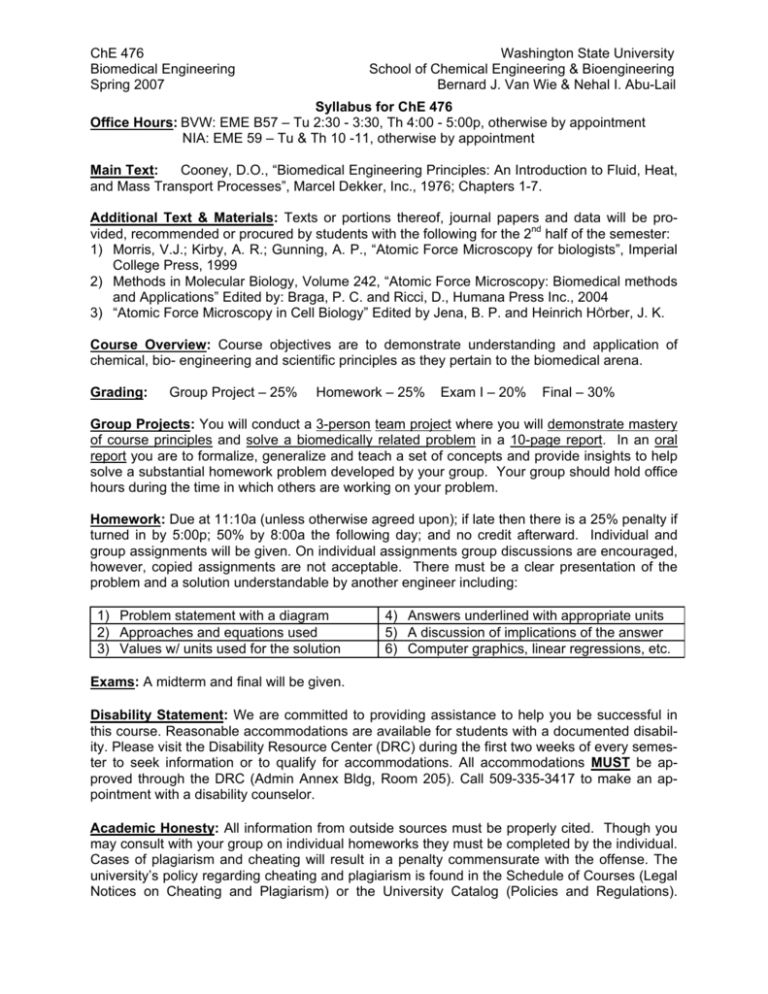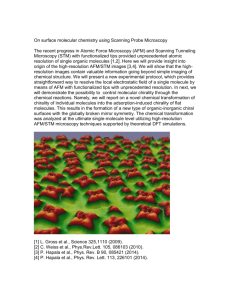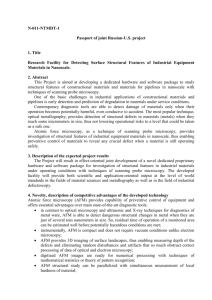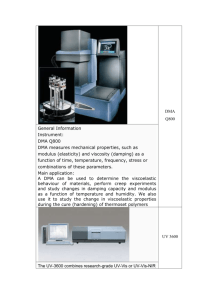ChE 476 Washington State University Biomedical Engineering
advertisement

ChE 476 Biomedical Engineering Spring 2007 Washington State University School of Chemical Engineering & Bioengineering Bernard J. Van Wie & Nehal I. Abu-Lail Syllabus for ChE 476 Office Hours: BVW: EME B57 – Tu 2:30 - 3:30, Th 4:00 - 5:00p, otherwise by appointment NIA: EME 59 – Tu & Th 10 -11, otherwise by appointment Main Text: Cooney, D.O., “Biomedical Engineering Principles: An Introduction to Fluid, Heat, and Mass Transport Processes”, Marcel Dekker, Inc., 1976; Chapters 1-7. Additional Text & Materials: Texts or portions thereof, journal papers and data will be provided, recommended or procured by students with the following for the 2nd half of the semester: 1) Morris, V.J.; Kirby, A. R.; Gunning, A. P., “Atomic Force Microscopy for biologists”, Imperial College Press, 1999 2) Methods in Molecular Biology, Volume 242, “Atomic Force Microscopy: Biomedical methods and Applications” Edited by: Braga, P. C. and Ricci, D., Humana Press Inc., 2004 3) “Atomic Force Microscopy in Cell Biology” Edited by Jena, B. P. and Heinrich HÖrber, J. K. Course Overview: Course objectives are to demonstrate understanding and application of chemical, bio- engineering and scientific principles as they pertain to the biomedical arena. Grading: Group Project – 25% Homework – 25% Exam I – 20% Final – 30% Group Projects: You will conduct a 3-person team project where you will demonstrate mastery of course principles and solve a biomedically related problem in a 10-page report. In an oral report you are to formalize, generalize and teach a set of concepts and provide insights to help solve a substantial homework problem developed by your group. Your group should hold office hours during the time in which others are working on your problem. Homework: Due at 11:10a (unless otherwise agreed upon); if late then there is a 25% penalty if turned in by 5:00p; 50% by 8:00a the following day; and no credit afterward. Individual and group assignments will be given. On individual assignments group discussions are encouraged, however, copied assignments are not acceptable. There must be a clear presentation of the problem and a solution understandable by another engineer including: 1) Problem statement with a diagram 2) Approaches and equations used 3) Values w/ units used for the solution 4) Answers underlined with appropriate units 5) A discussion of implications of the answer 6) Computer graphics, linear regressions, etc. Exams: A midterm and final will be given. Disability Statement: We are committed to providing assistance to help you be successful in this course. Reasonable accommodations are available for students with a documented disability. Please visit the Disability Resource Center (DRC) during the first two weeks of every semester to seek information or to qualify for accommodations. All accommodations MUST be approved through the DRC (Admin Annex Bldg, Room 205). Call 509-335-3417 to make an appointment with a disability counselor. Academic Honesty: All information from outside sources must be properly cited. Though you may consult with your group on individual homeworks they must be completed by the individual. Cases of plagiarism and cheating will result in a penalty commensurate with the offense. The university’s policy regarding cheating and plagiarism is found in the Schedule of Courses (Legal Notices on Cheating and Plagiarism) or the University Catalog (Policies and Regulations). ChE 476 Biomedical Engineering Spring 2007 Washington State University School of Chemical Engineering & Bioengineering Bernard J. Van Wie & Nehal I. Abu-Lail Spring 2007 Biomedical Engineering Semester Assignments Date Topic Reading Homework Due† 1/8 Introduction, History of Biomedical Engr. 1/10 Blood Properties Chapters 1 & 2 1/12 G: 2.1 to 2.4; I: 2.5 1/15 MARTIN LUTHER KING JR. DAY leisure 1/17 Blood Properties Chapter 3 Group Project Idea 1/19 G: Van Wie & Hustvedt model 1/22 1/24 Circulatory System Dynamics Chapter 4 Group Project Approval 1/26 G: 3.3; I: 3.4, 3.6 1/29 Chapter 5 1/31 Human Thermal System J. Appl. Physiol. 30, pp 779-786, 1971 2/2 G: 4.4 & 4.5; I: 4.9 & 4.10 2/5 2/7 Modeling Body Compartments Chapter 6 2/9 G: 5.3 & 5.5; I: 5.4 & 5.6 2/12 2/14 Transport through cell membranes Chapter 7 3-page group project report 2/16 G: 6.3, 6.4; I: 6.5 2/19 PRESIDENTS DAY leisure 2/21 G: 7.2, 7.4; I: 7.3, 7.5 2/23 Midterm Exam – Fluid Flow, Heat Transfer, Membrane Transport – Chapters 1-7 2/26 The atomic force microscope (AFM) 2/28 3/2 Imaging with AFM 3/5 3/7 Force Measurements with AFM Meet w/ profs for project 3/9 3/12 - 3/16 SPRING VACATION – NO CLASS 3/19 Macromolecules (DNA, RNA, Polysaccharides) 3/21 3/23 Forced Unfolding of Proteins 3/26 Ordered Macromolecules 3/28 Single Molecules Detection Project Problem 3/30 Cellular Investigation by AFM 4/2 Mechanical Properties of Cells 4/4 Scaling of AFM Measurements Project Problem Approval 4/6 Frictional Force Microscopy 4/9 Applying AFM to Study Contact Lenses 4/11 Applying AFM to Studies in Cardiac Physiology 4/13 Bio-Sensing using Micro-Cantilever Arrays 4/16-20 Group Projects 10-page report due Group project ideas may be from Chapters 8 – 11 on organs and artificial organs; articles on hepatic (liver) assist devices; cell separations; monoclonal antibody production; biosensors; nano-particles as vehicles for drug delivery, AFM imaging with carbon nano-tubes, AFM a tool for disease diagnostics, molecular motors, tissue engineering, etc. 4/23-27 Group Projects Group projects must be pre-approved by the professors and you must turn in preliminary project reports and meet with the professors at least once for assistance with project details. 5/1 Final Exam † G = Group Assignments; I = Individual Assignments







